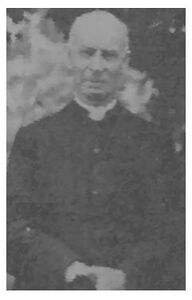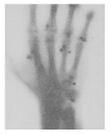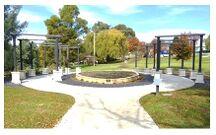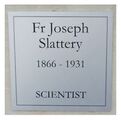Joseph Patrick Slattery

Joseph Patrick Slattery (1866-1931) was a Priest in the Congregation of the Mission who was born in Ireland and spent much of his life in Australia involved in education, in missions, retreats, and parish ministry, and in formation of seminarians. In his own time and later, he was also known for his work in radiology and wireless. He is the first Catholic priest to be commemorated on an Australian postage stamp.
Early life
Joseph Slattery was born in Waterford in the south east of Ireland on May 21, 1866, and was one of a number of children of John Slattery and his wife Hanna,(neé Walsh). He was educated at the Christian Brothers’ College, Waterford, and St Vincent’s College, Castleknock, Dublin (1877-86). His time as Castleknock has been described in the following words:
He followed a distinguished course of studies, applying himself seriously and methodically. As he grew older, he manifested a genius in getting at the heart of any problem and an extraordinary ability in carrying out experiments. He studied physics under the legendary Fr Richard Bodkin, in whose laboratory was an induction coil which was the gift of the inventor, the Reverend Professor N. Callan of Maynooth. He exhibited ability in music and in acting, taking leading parts in Shakespearean plays staged at the College. In 1886, his final year, he took the leading part in Macbeth. In the same year he was voted one of the 'Athletic Six’ to make arrangements for the sports; and he was captain of the 'Firsts' in football and cricket. In the University Examinations in the summer of 1886, five students in Ireland were awarded honours in Experimental Physics: two of these were from Castleknock, and one of these was Joseph Slattery.1
In September of 1886, Joseph Slattery entered St Joseph’s, Blackrock, Dublin, to begin training to become a Priest as a member of the Congregation of the Mission (Vincentian Priests and Brothers). While still a clerical student, he was asked to go to Bathurst, a town in the central west of New South Wales, Australia, to become a member of the Vincentian Community being set up there to conduct St Charles’ Seminary and St Stanislaus’ College.
Ingenuity at work
At St Stanislaus’ he taught courses in the natural sciences, with particular interest in chemistry and physics, at the same time continuing his studies for the priesthood. He also began to amass scientific equipment for the school laboratories, constructing some of the equipment himself. Some of this required the use of his skill of glassblowing.
On December 8, 1891 Slattery was ordained a priest in the college chapel and until 1911, he continued to teach chemistry, physics and geology at the college.
In 1893, he installed gas lighting fixtures with incandescent burners in the study halls, almost a year before these became available in Australia. In 1895, the college upgraded to an oil powered engine, dynamo and storage batteries that supplied electric light to the science halls. At the time, this was the only electric light in Bathurst. Then Slattery built an acetylene gas powered generator to provide stage lighting for the college theatre.2 In this period he developed an early interest in photography.

Inspired by the work of Wilhelm Röntgen in Germany, and events in Melbourne, Adelaide and Sydney, Slattery began work in the area of radiography. On July 26, 1896, he took a radiograph of the hand of 12 year old Eric Thompson enabling the surgeon Dr Edmunds to extract shotgun pellets from the hand, thus avoiding a possible amputation. The X-ray at left shows the position of the pellets in Eric Thompson’s hand and is a copy of that original radiograph.3 Slattery continued with his work in radiography, providing a service to local doctors and patients, at the same time communicating with Wilhelm Röntgen some of his improvements to the Crookes tubes he was using.4
In addition to his work in radiography, Slattery was interested in wireless telegraphy, and in July 1904 he transmitted wireless signals from the college to Kelso nearly five kilometres distant. He also wrote papers on wireless telegraphy.5
Move to Sydney
Joseph Slattery was transferred from Bathurst to Ashfield in Sydney in 1911. He spent the remainder of his life in parish ministry, in giving missions and retreats, in formation of seminarians at Springwood NSW, Manly NSW and Eastwood NSW, and finally as Vice Rector of St John’s College, University of Sydney. He brought the same thoroughness to all these ministries that he had exhibited at the College at Bathurst, and continued to show himself to be a dedicated and committed Vincentian Priest. He died at Lewisham Hospital in Sydney on March 31, 1931
Recognition
While Joseph Slattery himself did not always fully appreciate the importance of his work at Bathurst, he was not forgotten by others.
An Obituary in the Sydney Morning Herald newspaper on April 2, 1931, a few days after his death, includes AN APPRECIATION6 written by a student at Bathurst who knew Joseph Slattery personally:
“Jonnel” writes: It is 27 years since the writer’s close association as a schoolboy with Father Slattery, who was then science master at St. Stanislaus’ College, Bathurst. His was an outstanding personality. His knowledge of the various branches of science, particularly chemistry and physics, was profound. I remember well, as one of a small privileged class of five, my first insight into the wonders of wireless. We boys, guided by ‘Slatt’, succeeded in sending Morse to Kelso presbytery, a distance of five miles away towards Sydney. ‘Slatt’ used to astonish us with displays of lightning from his 14-inch induction coil, which incidentally, was the source of Hertzian waves, as we then knew them, for his wireless experiments. What excitement there was when occasionally one of us would be called to assist at the X-ray photographs for which ‘Slatt’ was famous in the district! Doctors from great distances would send their patients along to have needles, iron splinters, broken bones, and such little troubles located by ‘Slatt’ and his apparatus. His collection of photographs was a wonder to us. ............. He preferred to work unseen and unsung, otherwise his name would be among the first in Australia’s roll of scientists.
On November 29, 1936, a plaque to the memory of Joseph Slattery and his work on X-rays was erected on an interior wall of the entrance hall of St Stanislaus’ College, Bathurst, near a room which was formerly one of the college science laboratories in which Slattery worked.7
He received further recognition in 1965 at St Stanislaus’ College, Bathurst, with the building and naming of the Slattery Wing which included several science laboratories, and much later, in the 1990s the setting up of the Slattery X-ray Museum dedicated to him in the room off the main entrance hall of the college where he had carried out his medical work in radiography. This museum contains some of the equipment he used, some of the early glass X-ray plates he made, and other memorabilia including the plaque mentioned above.

In 1995, Australia Post recognised Joseph Slattery in a publication titled DISCOVERIES – MEDICAL SCIENCE IN AUSTRALIA.8 The chapter entitled “Getting Right Inside” discusses early developments in science and medicine in regard to radiology. In addition to the material provided in their publication, Australia Post issued a 45 cent postage stamp commemorating three men who made contributions to Australian medical science by their work in radiography - the three men being Thomas Lyle , Walter Drowley Filmer, and Joseph Slattery. Since it appeared unclear to the researchers of background material for the stamp as to which of these men should receive credit for being the first in Australia to perform medical radiography, Australia Post included all three on a postage stamp issued on September 7, 1995, to commemorate the 100th anniversary of Wilhelm Röntgen’s discovery of X-rays.9 The image of this postage stamp is shown at right.10 Note the inclusion of the Crookes tube at the right hand side of the image.


On March 29, 2015, The Pillars of Bathurst Commemorative Garden in Macquarie Park, Stanley St, Bathurst, was officially opened. The garden commemorates past citizens of Bathurst for their services to the Bathurst Region and Australia. There were twenty nine past citizens commemorated at that time (with allowances for more to be added later) and their names and their contributions to the community were remembered on plaques fixed to the bases of pillars (restored cast iron verandah posts from the old Royal Hotel in William St, Bathurst) set as shown in the photograph at left. Included in those remembered was Fr Joseph Slattery.11
(Note: The two photographs shown above were originally supplied by Russell Byers for Monument Australia - The Pillars of Bathurst web page. Copies of these two photographs are used here with the permission of Russel Byers.)
Talented and unpretentious
As a person, Joseph Slattery was of middle height and strong muscular build, unhurried and deliberate in movement. Somewhat stern in appearance, he could relax unexpectedly, smile and laugh heartily. He spoke with precision and grace. Exact, punctual, constant and exacting, he refused to tolerate foolishness in classes at Bathurst, or vagueness in answering, nor could he resist a slight sarcasm. His students at the College in Bathurst regarded him with awe and admiration.12
He was a man who never lost his natural reserve, being less persuaded than anyone else of the value of the aid he had given to the development of medical and surgical science since in Australia and to the technology associated with wireless telegraphy.13 This perspective was still part of him after he left Bathurst to carry out various ministries in Sydney. Sadly, before he died, he destroyed much of the records of his research and correspondence.
However, it seems that though Joseph Slattery himself may have appeared to undervalue the importance of his medical and radio work, there are many since who have remembered and appreciated him, together with his talents and skills. Had he known this was going to happen, he would probably have been amazed.
REFERENCES
1. Wilkinson, J., Father Joseph Patrick Slattery, CM, Journal of the Australian Catholic Historical Society, Vol. 9, No. 1, 1987, p 16
2. Wilkinson, ibid., p 18
3. Bourke, D.F., The History of the Vincentian Fathers in Australasia, Congregation of the Mission. Melbourne, Australia, 1982, Ch XI, p 93
4. Wilkinson, ibid., p 19
5. Wilkinson, ibid., p 23
6. Obituary: Father Joseph Slattery, An Appreciation, Sydney Morning Herald, Thursday 2nd April 1931. Accessed online through Trove, National Library of Australia, June 5, 2019, at: https://trove.nla.gov.au/news
7. Joseph Slattery, The Pillars of Bathurst Commemorative Garden, Monument Australia Website, P.O. Box 35, Halifax, Qld, 4850, Australia. Accessed June 12, 2019 at: http://monumentaustralia.org.au/themes/people/science/display/20254-joseph-slattery
8. Butcher, Barry and Whitechurch, Melinda, DISCOVERIES – MEDICAL SCIENCE IN AUSTRALIA, Getting Right Inside – The advent of X-rays, Australia Post , 1995, pp 18-19.
9. Joseph Patrick Slattery, Article, Wikipedia (English). Accessed June 7, 2019, at: https://en.m.wikipedia.org/wiki/Joseph_Patrick_Slattery
10. Medical Science Commemorative Stamp (45c), Joseph Slattery, Thomas Lyle, Walter Filmer, issued by Australia Post, September 7, 1995. Illustrators: Otto and Chris; © Australian Postal Corporation 1995
11. The Pillars of Bathurst Commemorative Garden, Monument Australia Website, P.O. Box 35, Halifax, Qld, 4850, Australia. Accessed June 12, 2019, at: http://monumentaustralia.org.au/themes/culture/community/display/108841-the-pillars-of-bathurst
12. Wilkinson, John, P., Slattery, Joseph Patrick (1866–1931), Australian Dictionary of Biography, National Centre of Biography, Australian National University, http://adb.anu.edu.au/biography/slattery-joseph-patrick-8453/text14863, published first in hardcopy 1988, accessed online 30 May 2019. This article was first published in hardcopy in Australian Dictionary of Biography, Volume 11, (MUP), 1988. View the front pages for Volume II
13. Wilkinson, John P., ibid.
RESOURCES
Bourke, D.F., The History of the Vincentian Fathers in Australasia, Congregation of the Mission. Melbourne, Australia, 1982
Butcher, Barry and Whitechurch, Melinda, DISCOVERIES – MEDICAL SCIENCE IN AUSTRALIA, Getting Right Inside – The advent of X-rays, Australia Post, Melbourne, 1995
Joseph Patrick Slattery, Article, Wikipedia (English). Accessed June 7, 2019, at: https://en.m.wikipedia.org/wiki/Joseph_Patrick_Slattery
Obituary: Father Joseph Slattery, An Appreciation, Sydney Morning Herald, Thursday 2nd April 1931. Accessed online through Trove, National Library of Australia, Canberra, ACT, June 5, 2019, at: https://trove.nla.gov.au/newspaper/article/16766378
Wilkinson, J., Father Joseph Patrick Slattery CM, Journal of the Australian Catholic Historical Society, Vol. 9, No. 1, 1987
Wilkinson, John P., Slattery, Joseph Patrick (1866–1931), Australian Dictionary of Biography, National Centre of Biography, Australian National University, Canberra, ACT, published first in hardcopy 1988. Accessed June 5, 2019, at: http://adb.anu.edu.au/biography/slattery-joseph-patrick-8453/text14863
